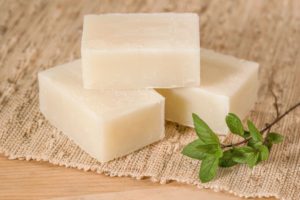Part II: Scent, color and natural additives
If you tried the basic soap recipe described in Part I, you got six cutlery tray “loaves” of soap out of their molds after two to three days when they were under wraps, finishing the saponification process. Most of the time, removing the soap from greased molds is a simple matter of giving the mold a little twist and then pushing down from the top and releasing the soap onto a sheet of waxed paper or directly onto the board where it is to be cut. On occasion, though, the soap is reluctant to leave the mold, and a couple of hours in the freezer following by repeating the twisting process usually does the trick.
This brings to mind a funny incident from years ago, when I had read somewhere that 3″ PVC pipe with an end cap at one end, stood up in a rack and poured from the top, made dandy round soaps. It was difficult to grease the inside of the pipes, which I had made about 18″ long, so I had sprayed the insides from both ends with candle release before putting the end caps on the bottoms. Not unexpectedly, it proved to be a chore to get soap out of a mold that was too rigid to be twisted, so I put the first two tubes into the chest freezer, propped up between bags of frozen veggies, and eagerly waited the two hours.
When the timer went off, my dog followed me to the kitchen (when a timer goes off, something good usually comes out of the oven – smart dog!). I pulled the end cap off the first tube, and with the slightest little push on the bulging end, whoosh! Out came the soap at the other end, like a projectile that barely missed the dog’s head and ended up having to be rinsed off after it thudded to the floor. Needless to say, the dog took one look at the second tube being pulled from the freezer and decided to forego the fun of seeing yet another thing that wasn’t edible come after him.
Now, keep in mind, if you’ve already graduated to the larger wooden molds that come unscrewed along two sides, the whole freezing business is never necessary as the mold is lined with a greased plastic bag and then the soap simply unwrapped and cut. Better yet, all-plastic molds are now available that don’t even need lining. There are as many methods and tools for cutting as there are for molding, too, from a simple kitchen knife (which is what I used on this first batch we did together) to multi-slice cutters that use thin, taught piano wire spaced at intervals and pushed down through the still-soft soap into grooves on a measured base. There are also planers for removing any ash residue from flat surfaces, and even bevellers that trim the squared edges of the cut bars to give them a professional look.
Before soap gets to this stage though, there are some other considerations I promised we’d talk about, starting with things that can be added to your soap at “trace.” As you recall, the trace stage is when you added any essential or fragrance oil before putting your soap to bed for a warm nap. But what if you had wanted to color your soap, or give it some special ingredients such as oatmeal? These, too, go in at trace, unless your additive is extremely delicate (we’ll talk about that in a minute).
In the case of oatmeal, a cup of rolled oats, thoroughly blenderized into a fine powder, would be a fine addition to your soap. A light fragrance oil like almond (but never use extract!) would be a perfect partner for a soothing oatmeal soap. A handful of lavender buds, also blenderized, could be added along with two ounces real essential oil of lavender for the perfect bedtime bath bar. A cup of white cosmetic clay makes a good, deep-cleaning soap, especially for oily skin. You get the idea – whatever is going in your soap has to be powdered fine enough not to clog drains, and often will add its own color so further pigmentation is unnecessary. If color is on your list of must-haves, it also goes in now, either as earth pigment powder, melted cosmetic wax chips, or even shaved bits of crayon.
But what if, instead of an herbal additive (or along with one) you also want to make your soap extremely emollient? Then you’d add a half-cup or so of room temperature oil, such as extra sweet almond oil or barely-melted shea or cocoa butter, stir it in thoroughly, and because this extra oil is above and beyond what is being saponified it is held in suspension and is called a “super-fatting” ingredient. These are fine ingredients to add for baby soap, and face or bath soap during harsh weather, or for people who tend to have chronically dry skin. They may cut down a little on the amount your soap will lather, but they will ensure that washing doesn’t strip the skin.
Now, a couple of paragraphs back, the idea of delicate additives was mentioned. What if the type of finely powdered flower petals or oils you want to use would either be discolored or worse, rendered useless by what remaining heat and caustic balance remains in the soap at trace? I’m thinking here specifically of calendula-infused oil, which I love for its soothing properties; honeysuckle-infused oil (there is no real essential oil available that I know of); real oil of rose; or aloe gel.
For these, a method called milling, or rebatching is best. In rebatching, the plain soap that comes out of the mold is grated just like cheese on a stainless steel grater (a food processor with a shredding blade might work, but I haven’t actually tried it yet) and then the shreds of soap are put into a double boiler and heated gently until they start to melt. Small amounts of water are drizzled and stirred in very gradually, until at last, a thick soap pudding is once again achieved and as it is allowed to cool, the delicate additives are stirred in just before pouring or ladling the soap back into its molds.
Along with preserving the therapeutic value and/or color of the additives, this method also frequently yields a harder finished product after curing than the original would have been. If you’ve ever looked at fine, boutique type soaps and seen printed on the label “Triple Milled”, you know that the soap you’re holding has gone through this grating, or milling, and then remixing and remolding a total of three times and hence, tends to be very hard and long wearing.
A final mention here about rebatching is that the hardening and addition of heat-intolerant ingredients serve the creative end of soapmaking; but the process also has a remedial use – it is a way of salvaging a batch that has come out either too high Ph, uneven and lumpy, or too brittle or crumbly. It can also be used, by adding more water and then not remolding, to make a serviceable liquid soap (am I the only one whose grandmother saved slivers of soap bars in a jar of water?).
Overall, after years of making soap and experimenting with such fanciful ideas as swirling natural pigment into the soap after it had been poured (the marbleized effect achieved by paprika stirred in spirals with a toothpick was a hit one year) and brushing a thin layer of paraffin over a pressed flower on the top surface of a flat bar as an embellishment in a daisy-themed gift basket, I’ve come to appreciate the simplest recipes and forms the most. I like the way vanilla scent oil turns the soap a rich caramel color, and I cut it in substantial blocks that last through a lot of showers. Calendula and sea buckthorn berry oils produce a soothing, golden bar and it’s fun using the trimmings to form soap balls that look like small fruit.
As with any kind of kitchen wizardry, certain recipes become family favorites and the same thing produced by five different cooks will produce five different results; but they’re all good, they’re all very personal and they evolve as the soapmaker’s skills and tastes change over time. I encourage you to get the basics down first, and then later, armed with a good lye calculator that will clearly give correct proportions of lye to each type of fat or oil, by all means, experiment. There are good discussion lists online, and there is actually at least one soapmakers’ guild I know of that’s a treasure trove of information from experienced people. Be careful, have fun, and let your imagination out of its box!

































[…] Part II, we’ll look at not only such techniques as superfatting, but “filled” soaps, […]